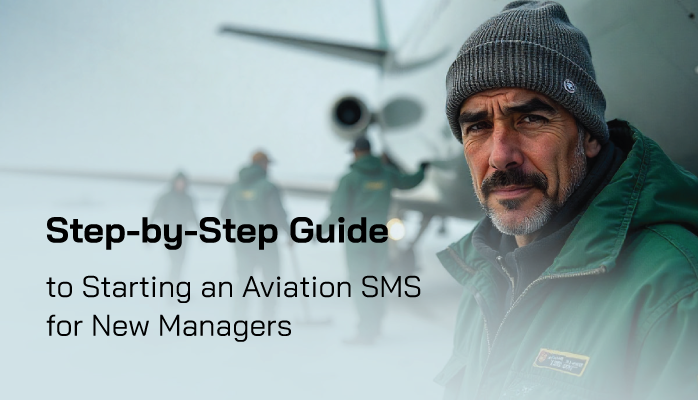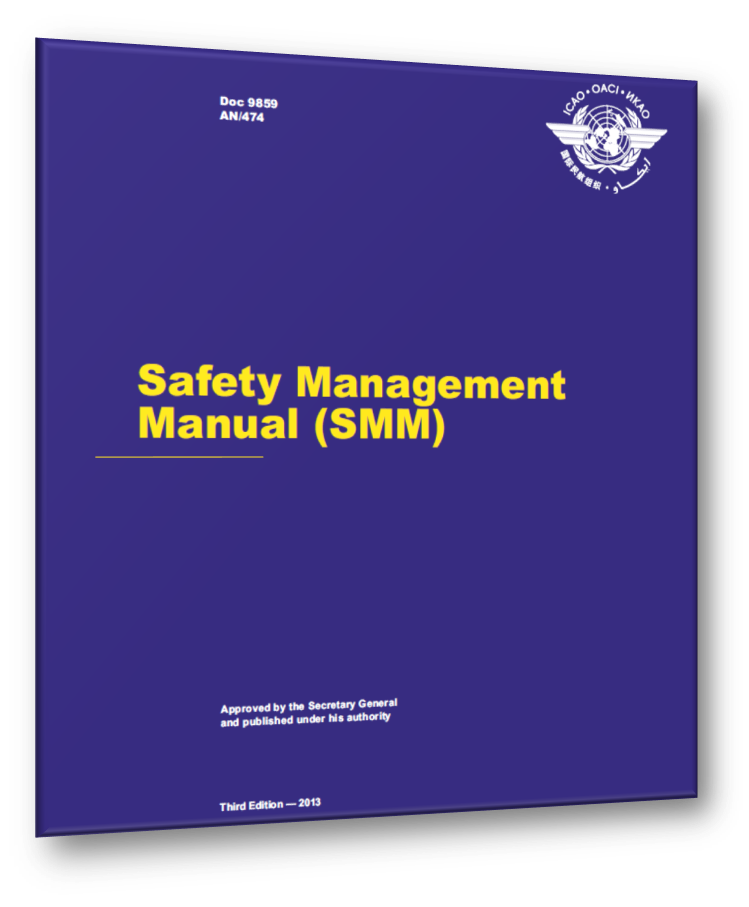The Frustration of Monumental Tasks of SMS Implementation

Many aviation safety managers happen upon the task of "safety manager" by chance. The previous safety manager may have:
- Quit the company;
- Been promoted to another position; or
- Been replaced due to poor performance.
Regardless, new safety managers have a very tough task. Most aviation service providers only have the budget for one safety manager; therefore, when one suddenly leaves the company, a huge vacuum exists.
Related Articles on Aviation Safety Managers
- How to Tell If Aviation Safety Manager Is Doing Their Job
- 5 Types of Aviation Safety Managers
- Career Advice for Aspiring Aviation Safety Managers
It may be that your company never had a "safety manager" formally directing risk management processes.
This article will highlight some of the most important elements in starting a professional aviation safety management system (SMS). After working with hundreds of operators implementing their SMS, I have made some interesting discoveries and I'll share them here.
Starting an Aviation SMS With Tried Processes

First and foremost read the manual! Which manual? I will always recommend starting with the International Civil Aviation Organization (ICAO) document 9859, the Safety Management Manual (SMM). Read it very carefully. It is not a difficult read and you will benefit from reading it at least a couple of times. Version #4 came out recently and there is some online training also available on the ICAO website.
Read this before you read your own civil aviation authority's SMS documentation because ICAO is the root of the SMS requirement, which went into effect in November 2006.
Again, read document 9859! This is the bible. My interesting discovery is that this is perhaps the best resource available. Most CAAs (civil aviation authorities) are regurgitating these requirements and for good reason.
There must be harmony within the standardization processes. If you can follow ICAO's processes as documented in 9859, you will be off to a great start.
Reading the manual may seem like an obvious idea, but some safety managers need "coaching" and "mentoring." This message is for those who need to read the "documentation" in order to understand an incredibly important point: You need to read the documentation in order to understand the SMS documentation requirements.
Understanding Documentation Prepares Way for SMS Data Planning
These documentation requirements are no joke and have caught hundreds of safety managers and accountable executives with their guard down. The reason that you understand the SMS documentation requirements is so you can properly plan your SMS data management strategy. Many safety managers are superheroes and many are super users of a computer.
Superhero safety managers will try several strategies to manage their SMS data. I've been around long enough to see the evolution of SMS data management strategies and here is what I've seen:
Early in the SMS implementation, safety managers from smaller, non-complex companies with fewer than 60 to 120 employees will try to manage everything using email and spreadsheets. Copy and pasting, copy and pasting:
- Reported safety issues;
- Hazard register;
- Safety risk analysis history;
- Accident investigations;
- Audits;
- Safety Surveys;
- SMS training, etc.
After a couple of years of seeing little SMS activity, they realize SMS really doesn't work as they envisioned. Their safety culture suffers while safety managers go through the spreadsheet phase of their SMS data management maturity. Why are their safety cultures suffering?
The reason spreadsheets hurt safety cultures is simple: spreadsheets are the wrong technology to store SMS data for all but the very small companies. Safety manager will be spending their best working hours managing SMS data. Meanwhile, the other SMS tasks are being ignored, such as developing the safety culture.
Furthermore, if you have fewer than 30 employees with very low turnover, you may get by with spreadsheets; however, if you have high employee turnover, you need to get away from spreadsheets. This is an accident waiting to happen and the accountable executive will not be pleased.
Related Articles on Using Spreadsheets to Manage Aviation SMS Data
- 5 Things Spreadsheets Can't Do for Your SMS
- Spreadsheets vs Software for Aviation Safety Management
- See How Spreadsheet Not EASA Compliant Aviation Hazard Reporting Database
Point Solutions or Hacked In-House Tools Next
Another data management strategy safety teams try is to purchase point solutions to address particular business requirements, such as:
- Safety reporting system;
- Risk management software; or
- Auditing system.
This is commonly seen as the first step for operators with more than 100 employees. This will often, but not always be the second step for safety teams that realize that spreadsheets were not sustainable for managing many years worth of SMS documentation.
Point solutions may take SMS implementations through their first four to six years after an operator starts the SMS implementation process. As auditors demand more sophistication from supposedly mature SMS implementations, aviation service providers realize that the point solutions do not satisfy all the SMS documentation requirements.
The biggest problem I've seen with companies using point solutions is that their "systems" do not talk to one another. For example, there is no way for their hazard register to be tied into their reactive risk management processes so they can easily monitor risk controls. Another example may be that there are no automated emails when users are assigned tasks or no email notifications are sent alerting management that SMS tasks are not being performed.
In short, the point solutions make it very difficult for management to monitor the performance of the SMS.
SMS Performance Monitoring Required Process

The third step in SMS data management maturation is the adoption of SMS database software that satisfies all regulatory requirements. After the spreadsheets and the failed point solutions, many companies move to commercially available SMS databases not because they want to, but because they continue to receive audit findings. It will usually take about two to four years of repeat audit findings before the beleaguered safety team realizes they didn't plan very well in the early stages of their SMS implementation.
Finally, we get to the point of why it is important to read the SMS documentation requirements when you start an SMS implementation. Many safety teams have suffered the pain. You don't need to.
Related Aviation SMS Database Articles
- What Is an Aviation Safety Database
- How to Choose the Best Aviation Safety Database Software
- 3 Benefits of Aviation Safety Management System (SMS) Databases
Gain Top Management Support
The number one reason that aviation SMS fails is due to a lack of leadership from the highest executive. If you don't have top management support, or you feel that you are losing it, then you will need to focus strongly on this most important element.
How do you know you don't have top management support?
- No routine meeting with top executive;
- No recent affirmation of the CEO or President's Commitment to Safety;
- Lack of adequate safety budget; or
- Reluctance to contribute to safety initiatives (safety meetings, newsletters, etc).
Safety managers must have an excellent rapport with top management and especially the accountable executive. The entire organization must know that the boss supports you. One tactic is to be seen walking around the area of operations with the top dog. Be bold. Explain to the accountable executive that their time is valuable; however, a strongly visible display of top management support of the SMS is to be seen with the safety manager. Other managers and employees will see that the boss supports your efforts to implement the SMS.
Visible displays of support by top management are critical to developing a strong safety culture.
One strategy to reinforce top management support is to educate the accountable executive as to his responsibilities to the SMS. Talk to him about attending an SMS leadership course or an Executive Level SMS Workshop.
If the safety manager is getting push-back or resistance from the accountable executive to get SMS training for executives, consider reminding him, tactfully of course, of his responsibilities. Every accountable executive is responsible for making sure their SMS is properly implemented and performed in all areas of the organization. In addition, accountable executives are required to review organizational safety performance on a regular basis and manage activities to address substandard safety performance.
Top management support is critical, as SMS implementations are a top-down approach, meaning that it all starts with the accountable executive.
Identify the Safety Champion
Let's face it. Not every safety manager possesses the charm and charisma to move the masses. If you don't have these skills, look for a safety champion to help with the task.
Change management is incredibly important for aviation service providers implementing formal aviation SMS. Change managers must be effective and strongly persuasive communicators. If you cannot be this "safety champion," talk to top management to explore some options, such as:
- Hire a temporary consultant;
- Attend aviation SMS courses to strengthen your skills; or
- Find someone more suitable for implementing the SMS.
Being a safety manager can be a thankless task early on in the SMS implementation. Depending on your safety culture, you may face considerable resistance from resentful employees.
Surprisingly enough, the strongest resistance does not come from line-level employees, but from middle to upper-level management. These managers are very good at their jobs and have been "flying safe" all these years without accidents and now we have all this work to do that adds no real value to the bottom line... and on and on...
Uncovering this resistance to change early on in the SMS implementation is very important for successful safety teams.
Related Articles on Resistance to Aviation SMS
- How to Reduce Resistance to Aviation SMS With Difficult Employees
- 4 Tools to Find Resistance to Your Aviation SMS - With Free Resources
- Overcoming Resistance to Change through Transparency in Aviation SMS
Perform a Gap Analysis
Most aviation service providers have existing elements of formal aviation SMS. SMS requirements didn't suddenly drop from the sky. All operators, before even considering an SMS implementation, have been practicing reactive risk management processes, but these processes may not be documented. Something breaks, fix it.
While these operators have existing risk management processes, they may not be well defined, documented or the operator has no way to measure the results to demonstrate continuous improvement of their "systems."
An aviation SMS gap analysis will indicate which elements you have and which elements you need to work on. Also, a gap analysis is the second best way to understand SMS documentation requirements after reading ICAO Document 9859. The gap analysis (except the IS-BAO gap analysis model), will educate the safety team as to future SMS data management requirements.
Gap analysis checklists come in many different models, including:
- ICAO (recommended);
- FAA (second best);
- Transport Canada;
- IS-BAO (very poor); and
- Hybrids (combination of all, with duplicates removed).
Most operators are well served by using the ICAO gap analysis model. It is my recommendation. Some advanced SMS database tools offer hybrid gap analysis models that take the best from all models and combine them. If you only want to "check the box," choose a model appropriate to your region.
In the beginning years of SMS implementation, we recommend that operators perform a gap analysis each year to demonstrate continuous improvement. Better SMS software tools should depict your progress in easy-to-read charts or graphs.
Most gap analysis models are available in spreadsheets unless you select an SMS database that has these checklists built into the system. That is a best practice - keep all SMS documentation within one system. Your audits will be much smoother and auditing time can be reduced to a few hours instead of an entire day or even two days.
Related Articles on Aviation SMS Gap Analysis
- What Is a Gap Analysis in Aviation SMS?
- SMS First Steps - Gap Analysis
- 4 Best Aviation SMS Gap Analysis Strategies for SMS Implementations
Create an SMS Implementation Plan

After performing the gap analysis, you will need to develop a plan to implement the aviation SMS. This is commonly done using an SMS implementation model. An implementation model is a list of SMS activities organized into logical implementation phases. For the ICAO SMS implementation plan, there are four phases:
- Phase 1: Planning SMS Implementation;
- Phase 2: Reactive Risk Management Processes;
- Phase 3: Proactive and Predictive Safety Management Processes;
- Phase 4: Safety Assurance.
The best SMS implementation models are:
- ICAO (recommended);
- Transport Canada;
- IS-BAO (surprisingly good despite poor gap analysis model); and
- FAA (discontinued).
After choosing an SMS implementation model,
- review the implementation activities;
- set proposed start date for each activity;
- set estimated completion dates for each activity; and
- track accordingly.
SMS implementation plans can be tracked in MS Project or other aviation SMS database tools. The better aviation SMS software tools will allow you to modify the implementation plan to suit an operator's specific needs. For example, a helicopter operator will have different requirements than an airport.
Final Thoughts on Starting an SMS Implementation
There are many elements to an aviation SMS. They may appear daunting to new aviation safety managers. Often the most difficult part of a new job is understanding where to start and what are the requirements.
I believe that these three elements are most important when starting a formal, ICAO-compliant aviation SMS. To recap:
- Gain top management support;
- Perform a gap analysis; and
- Create an SMS implementation plan.
Each year, I see three or four SMS failures. I also see safety managers pick up failed SMS and go through the process all over again but at a different company. These safety managers have tried:
- Spreadsheets;
- Point solutions;
- Hybrid point solutions (integrated point solutions sold to many industries, like chemical, auto, food); and
- Built-for-Purpose SMS databases.
These repeat safety managers will always choose the commercially available SMS database that was built to address SMS documentation requirements.
The best way to start an SMS is to:
- learn the requirements;
- get top management support; and then
- immediately select an SMS database provider.
For example, SMS Pro has an SMS manual template that can be used to jump-start an SMS with documented risk management processes. Acquiring an SMS database from the beginning will save you considerable pain and reduce risk to the accountable executive.
Your SMS database provider will become your SMS partner, so choose wisely. Before you select an SMS database, I encourage you to review: 5 Most Important Things to Know Before Buying Aviation SMS Database.
Related Articles on SMS Implementation
- Why Should We Implement Aviation SMS?
- How to Create Aviation SMS Implementation Plan - With Templates
- Is Your Aviation SMS Implementation a Farce? - With Self Assessments
If you are looking for an SMS database, please watch these videos to see whether we are a good fit. If you have questions, you can schedule a live demo.
Good luck starting your SMS implementation.
Live SMS Pro Demo
- Regulatory Resources:
- FAA: SMSVP Guide, AC 120-92B, and SMS Gap Analysis Tool (faa.gov).
- ICAO: Safety Management Manual (Doc 9859) (icao.int).
- EASA: Management System Assessment Tool (easa.europa.eu).
- Industry Resources:
- Online Platforms:
- Aviation Safety Network (aviation-safety.net) for case studies.
- SMS Pro (asms-pro.com) for free and paid templates.
Last updated August 2025.









